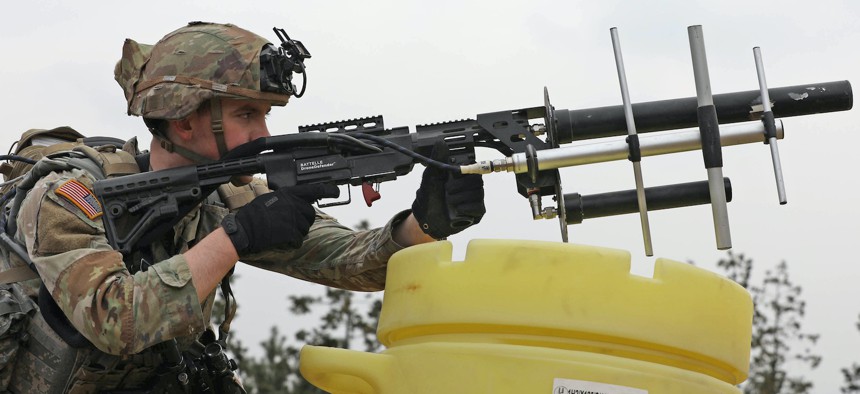SAM SKOVE

“Look up,” Sgt. Maj. Demetrius Johnson, a leader in the Army’s anti-drone effort, told a crowd at the AUSA trade show. “You’ve just had the first step of training for counter-UAS.”
A ripple of laughter went through his audience, but the lesson grows more pertinent by the day as the Army works to bolster its counter-drone forces against a growing threat. The service’s effort now extends from basic soldier education to the dispatch of drone-killing trucks to Ukraine.
They also include equipping individual platoons with handheld and electronic-warfare anti-drone systems, according to leaders in the Army’s Joint Counter-small Unmanned Aircraft Systems Office (JCO), which develops the military’s response to class-one, -two, and -three drones ranging from 250 grams to over 1,000 pounds.
“We've just fielded two divisions with counter-UAS capability,” said Maj. Gen. Sean Gainey, director of the JCO. “The intent is to go down to the platoon level with handheld capability and [electronic warfare] capability.”
Gainey said it will be up to the divisions—the 82nd Airborne and 1st Cavalry—to decide how to assign soldiers to operate the weapons. But he said they are not meant to be restricted to specific Army specialties, such as indirect fire specialists or infantry.
The Army is also looking into ways to make sure anti-drone soldiers are able to deconflict within sometimes crowded airspaces, said Lt. Col. Johnathan Hester, a JCO requirements officer.
In fiscal year 2024, the Army hopes to field more of the Army’s Mobile-Low, Slow, Small Unmanned Aircraft Integrated Defeat System, or M-LIDS, across divisions to defeat heavier, class three drones, added Gainey.
Some M-LIDS vehicles will carry a 30mm gun and an electronic-warfare weapon to counter drones, Gainey said. Leonardo DRS Land Systems is the developer and integrator of the air defense systems on the M-LIDS. The M-LIDS will be “integrated into divisions to be employed at the company and brigade-type level,” he said. “Two divisions have already started with the intent to get 10 division sets.”
In April, Leonardo DRS’s Aaron Hankins said that the Army wanted to equip nine divisions with five sets of M-LIDS each, and would start fielding systems next year.
The JCO also wants to see a heavy emphasis on drone education, said Sgt. Maj. Johnson, the JCO’s senior enlisted advisor. “Every warfighter needs to have a basic education of counter-UAS.”
The JCO is also involved in real-world operations, including the imminent deployment of anti-drone gun trucks to Ukraine, said Col. Mike Parent, acquisition chief for the JCO.
“You can probably expect to see it on the ground very shortly,” Parent said.
The JCO first tested Northrop Grumman’s Agnostic Gun Truck, or AGT, in a shoot-off in January in response to an urgent request from the Pentagon to field a weapon good against class-three three drones. At the time, Russia was using Iranian-supplied Shahed class-three drones to black out Ukrainian cities by striking electrical power stations, a tactic it may repeat again this winter.
The AGT system consists of a battery of three trucks mounting 30mm autocannons in addition to a radar system to help the guns target. The autocannons fire shells that burst when close to their target, Northgrop Grumman representatives previously told Defense One.
The AGT, an experimental design not in serial production for Northrop Grumman, was originally meant to be delivered within 30 to 90 days of a contract award. However, Northrop Grumman representatives told Defense One that delays in the procurement process meant that as of early August the full complement of trucks had not been built.
Parent praised the system as extremely effective against drones: “It's a fantastic system.”
While noting the Army would need a range of systems to counter drones, he also called out the value of 30mm rounds for destroying small drones. “We’re finding great promise with 30mm” for drones up to 55 pounds, he said.
CENTCOM is also testing the same autocannon system, Gainey said.
While many drones can be attacked with electronic warfare to cut the connection between drone and drone operator, counter-drone companies have told Defense One that loitering munitions are increasingly relying on an inertial guidance system to guide them to their target.
In September, MARSS’ head of sales Silje Jahr told Defense One that company clients are increasingly seeing adversaries fly the final kilometers on internal guidance systems only.
Explosives are far from the only counter-drone system the Army is using. Gainey said high-powered microwaves might provide a “better capability” against multiple drones. The JCO is planning tests against swarms of drones in October or November.
No comments:
Post a Comment